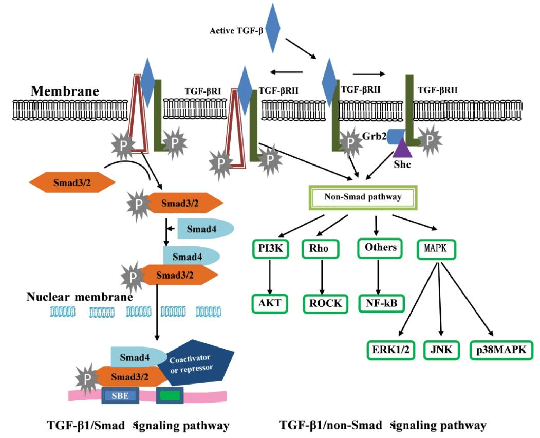1. TGF Beta Pathway in Cancer
TGF-beta 1 is a multifunctional protein, which can control the proliferation, differentiation and other functions of many cell types. It's the efficient activator for the osteoblast bone formation and can cause the chemotaxis, proliferation and differentiation of shaped osteoblast. Thus, it plays an important role in bone remodeling. Once cell loses the sensitivity for TGF-beta1 induced growth inhibition, autocrine TGF-beta signaling can promote tumor development. In advanced cancer, the increase of TGF-beta1 level is usually observed, and associated to tumor invasiveness as well as disease progression.

2. TGF Beta Inhibition
TGF-beta 1 is the member of TGF-beta family. TGF-beta polypeptide family is involved in regulating cellular process, including cell division, differentiation, movement, adhesion, and death. TGF-beta 1 positively and negatively regulates many growth factors. It inhibits the secretion and activity of many cytokines, including IFN-γ, TNF-α and various interleukins. TGF-beta 1 can decrease the expression level of cytokine receptors, and also increase the expression of some cytokines in T cell as well as the promoted proliferation, especially for immature cells.
TGF-beta 1 also inhibits B cell proliferation and stimulates the apoptosis. Meanwhile, it plays an important role in controlling the expression of antibodies, transferrin and MHC Class II proteins in immature and mature B cell. For myeloid, TGF-β1 can inhibit the proliferation and prevent the production of reactive oxygen and nitrogen intermediate. However, like other cell types, TGF-beta 1 reacts on bone marrow-derived cells.
3. TGF Beta Signaling Pathway
TGF beta 1 precursor protein can be cut into LAP and TGF beta 1 (Transforming growth factor beta-1) in the Golgi apparatus. The noncovalent binding between LAP and TGF beta 1 inactivates TGF beta stored in extracellular matrix. When the integrin binds with LAP, the TGF beta 1 will be released. Then, it binds with the receptor for signal transduction.
The full length of active TGF beta 1 protein is 44 kDa. The sliced mature TGF beta 1 protein is 13 kDa. Mature TGF beta 1 can form homodimer(25 kDa) and heterodimer with mature TGF beta 2 respectively.
4. Recommended Proteins
|
Product Name |
Cat. No. |
Expression Sys. |
Size |
|
Recombinant Human TGFB1 |
HEK293 Cells |
50μg/100μg/200μg |
|
|
Recombinant Mouse TGFB1 |
E.Coli |
50μg/100μg/200μg |
|
|
Recombinant Mouse TGFB1 |
HEK293 Cells |
50μg/100μg/200μg |
|
|
Recombinant Rat TGFB1 |
E.Coli |
50μg/100μg/200μg |
REFERENCES
[1]Targeting TGF-β signal transduction for fibrosis and cancer therapy, PMID: 35461253.
[2]TGF-β and the Tissue Microenvironment: Relevance in Fibrosis and Cancer, PMID: 29701666.
